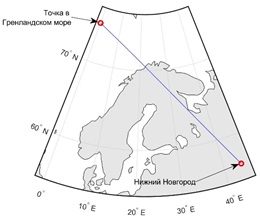
Technique for Automatic Profiling of Underlying Surface Electric Parameters on the Very Low Frequencies Radio Path
https://doi.org/10.31854/1813-324X-2024-10-3-66-73
EDN: MHACGD
Abstract
Relevance. Information about the electrical characteristics of the underlying surface has a significant impact on the calculations results of the radio tracks energy parameters in the very low frequency band. Currently, various versions of developed digital maps can potentially improve the accuracy of calculations and simplify the operator's activities in the initial data input. However, the capabilities of digital cartography are not integrated into existing forecasting techniques. The purpose of the study is to reduce the number of manual operations during the forecasting of the radio tracks energy parameters in the very low frequency band by developing a technique that allows to automate the input of the underlying surface electrical parameters. Methods. In this study we used methods of mathematical statistics to choose the quantization levels of radio tracks electrical parameters rationally. We used an interpolation method with a given decimation coefficient to obtain an electrical characteristics profile that meets the requirements of the forecasting methodology. Result. We selected the levels and quantization intervals of the underlying surface electrical characteristics which are needed to obtain the horizontal profiles, using statistical estimates. Further, we performed interpolation with the «nearest neighbor» method with a given decimation coefficient to exclude areas with frequent changes in the profiling parameters values. The decimation coefficient relies on the condition that the smallest length of a homogeneous section should not be less than the wavelength. The developed technique is implemented in the Matlab modeling environment as a combination of scripts and auxiliary functions. We provided an example of the technique application as the forecasting the ground wave field strength on a heterogeneous track. The novelty lies in the development of an original technique that provides rational profiling of the underlying surface electrical conductivity and dielectric permittivity for the subsequent usage of the obtained data in the forecasting the radio tracks energy parameters in the very low frequency band. Practical significance. The developed technique makes it possible to reduce the operator load during the initial data input and increases the accuracy of presenting this data. The technique can be used in a wavehop method for the predicting the radio tracks energy parameters to determine the vector sum of spatial and ground waves at the receiver.
About the Authors
A. A. TipikinRussian Federation
V. A. Pakhotin
Russian Federation
D. S. Potapov
Russian Federation
References
1. Coleman C. Analysis and Modeling of Radio Wave Propagation. Cambridge: Cambridge University Press; 2017. 296 p. DOI:10.1017/9781316798607
2. Gonzalez G. Advanced Electromagnetic Wave Propagation Methods. Boca Raton: CRC Press; 2022. 708 p.
3. Bilitza D. IRI the international Standard for the ionosphere. Advances in Radio Science. 2018;16:1‒11. DOI:10.5194/ars-16-1-2018
4. Froń A., Galkin I., Krankowski A., Bilitza D., Hernández-Pajares M., Reinisch B., et al. Towards Cooperative Global Mapping of the Ionosphere: Fusion Feasibility for IGS and IRI with Global Climate VTEC Maps. Remote Sensing. 2020;12(21):3531. DOI:10.3390/rs12213531
5. Galkin I., Fron A., Reinisch B., Hernández-Pajares M., Krankowski A., Nava B., et al. Global Monitoring of Ionospheric Weather by GIRO and GNSS Data Fusion. Atmosphere. 2022;13(3):371. DOI:10.3390/atmos13030371
6. Tipikin A.A., Potapov D.S. Evaluation of the electrical characteristics of the soil on the path of propagation of surface radio waves. Tekhnika radiosvyazi. 2022;1(52):19‒29. (in Russ.) DOI:10.33286/2075-8693-2022-52-19-29
7. Tipikin A.A. Method of obtaining global digital maps of underlying surface electric characteristics in the very low frequency band. Computing, telecommunication and control. 2022;15(1):7‒18. (In Russ.) DOI:10.18721/JCSTCS.15101
8. Tipikin A.A., Parafejnik D.V., Potapov D.S. The Research Results on the Development of Digital Cartographic Data of the Electrical Characteristics of the Underlying Surface in the Very Low Frequency Band. Morskoj vestnik. 2023;S1(16):27–29. (In Russ.) EDN:JDEEVY
9. Morgan R.R. World-wide VLF effective conductivity map. Report 8013F-1. Morgan R.R. Westinghouse Electric Corporation, 1968. 62 p.
10. ITU-R Recommendation P.832-4. World atlas of ground conductivities. July 2015.
11. Bashkuev Yu.B., Angarkhaeva L.Kh., Buyanova D.G., Advokatov V.R. Predictive map of geoelectric sections of continents of the world. Proceedings of the V International Scientific-Technical Conference on Radio Engineering, Electronics and Communications, 07–09 October 2019, Omsk, Russian Federation. Omsk: Omsk Scientific-Research Institute of Instrument En-gineering Publ.; 2019. p.17−24. (In Russ.) DOI:10.33286/978-5-6041917-2-9.17-24. EDN:DKVXOV
12. Tipikin A.A. The technique of calculating the field strength of the ionospheric wave in the very low frequency band based on the wavehop method. Information and Control Systems. 2023;5:12–21. (In Russ.) DOI:10.31799/1684-8853-2023-5-12-21. EDN:FTXMCY
13. Kuchmin N.A., Nikitin O.R. Quantizers for speech signal. The Scientific Heritage. 2021;81-1(81):46–50. (In Russ.) DOI:10.24412/9215-0365-2021-81-1-46-50. EDN:WBHCVJ
14. Trubakov A.O., Seleykovich M.O. Comparison of interpolation methods for raster images scaling. Scientific and Technical Journal of Bryansk State University. 2017;1:92–97. (In Russ.) DOI:10.22281/2413-9920-2017-03-01-92-98. EDN:YHFCGF
15. Tipikin A.A. Generalized method to calculate field strength of ground wave in very low frequency band for a path with arbitrary number of homogeneous segments. Vestnik of Ryazan State Radio Engineering University. 2024;87:21–28. (In Russ.). DOI:10.21667/1995-4565-2024-87-21-28. EDN:NRQFAG
16. Dembelov M.G., Bashkuev Yu.B., Melchinov V.P. Field of the earth wave over long inhomogeneous radio paths. Journal of Radio Electronics. 2019;11. (In Russ.) DOI:10.30898/1684-1719.2019.11.11. EDN:NASWEE
17. ITU-R Recommendation P.368-9. Ground-wave propagation curves for frequencies between 10 kHz and 30 MHz. 2007.
18. Pal S., Basak T., Chakrabarti S.K. Results of Computing Amplitude and Phase of the VLF Wave Using Wave Hop Theory. Advances in Geosciences. 2011;27:1–11. DOI:10.1142/9789814355414_0001
19. Gasdia F., Marshall R.A. A New Longwave Mode Propagator for the Earth-Ionosphere Waveguide. IEEE Transactions on Antennas and Propagation. 2021;69(12):8675‒8688. DOI:10.1109/TAP.2021.3083753
20. Marshall R.A., Wallace T., Turbe M. Finite-difference modeling of very-low-frequency propagation in the Earth-ionosphere waveguide. IEEE Transactions on Antennas and Propagation. 2017;65(12):7185–7197. DOI:10.1109/TAP.2017.2758392
Review
For citations:
Tipikin A.A., Pakhotin V.A., Potapov D.S. Technique for Automatic Profiling of Underlying Surface Electric Parameters on the Very Low Frequencies Radio Path. Proceedings of Telecommunication Universities. 2024;10(3):66-73. (In Russ.) https://doi.org/10.31854/1813-324X-2024-10-3-66-73. EDN: MHACGD

































